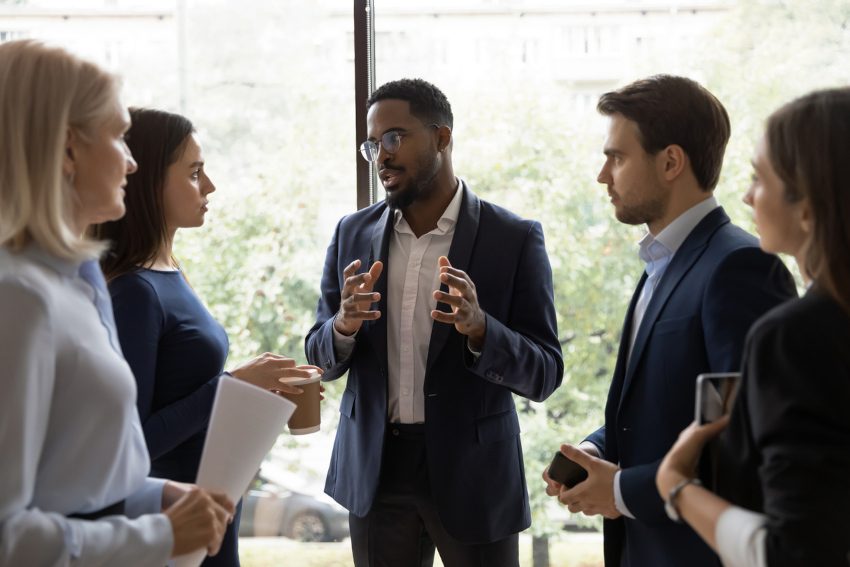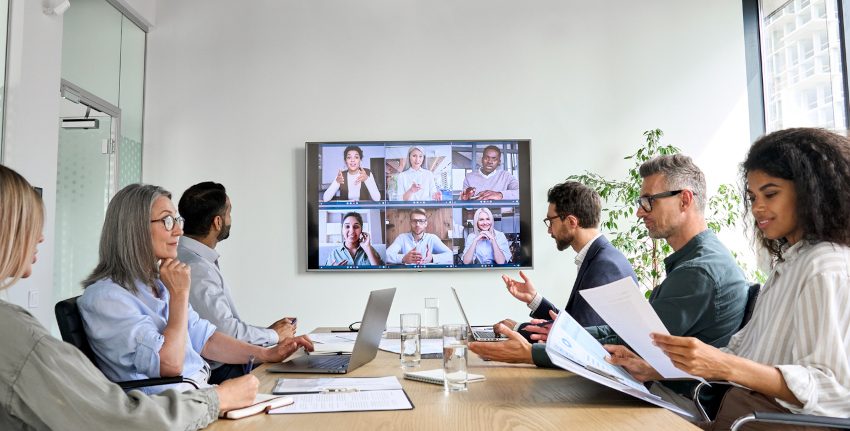What Is Employee Communication? A Comprehensive Guide
Modern workplaces have a lot of information to share with employees, from new policies to company targets and upcoming changes. Further, employees need to communicate with their peers as they collaborate on projects. The efficiency with which such information travels in your organization impacts how successful the company is. For example, digital signage enhances internal communication, which leads to 25% higher employee productivity.

Indeed, businesses with effective employee communication strategies are 3.5 more likely to outperform their competitors. Hence, organizations need to rethink how they communicate with employees and adopt best practices to keep employees informed and engaged.
What Is Employee Communication?
Employee communication describes the exchange of information and ideas between staff and managers. Effective employee communication is quite challenging to get right, whether you are a startup with ten employees or a multinational with hundreds of employees in different countries.
However, improving your employee communication strategy sets up your establishment for success as it impacts productivity, employee morale and engagement, and company culture. Despite the benefits of employee communication, many companies don’t prioritize the development of effective communication strategies. In fact, over 60% of organizations have no long-term internal communication strategy. But, with the right tools and approach, you can revolutionize workplace communication in your company.
A Brief History
Traditionally, businesses based employee communication on a top-down structure, where managers circulated policies and procedures via memos and posters on notice boards. Managers supplemented paper-based communication with face-to-face communication.
The fax machine marked a new era in internal communication, as people could quickly share information in different locations. Subsequent technological advancements in landlines, computers, employee intranet, and mobile phones improved how managers shared instructions and gathered feedback.
Today, the explosion of social media and communication apps favors two-way communication over top-down structures. Additionally, businesses are placing employee engagement and communication at the forefront to outperform competitors.
Companies are especially prioritizing communication with frontline workers, as they represent 80% of an organization’s opportunity for improvement. Ultimately, companies need to adopt an omnichannel approach to employee communication that includes traditional and modern communication modes for the best results.
Benefits of Employee Communication
The way a business communicates with staff members substantially affects employee experience, productivity, and engagement. Effective employee communication is essential because it:
Increases Productivity

An effective communication strategy that includes getting clear instructions to employees on time elevates productivity. As it stands, 97% of employees believe communication affects how efficient they are in daily tasks.
If an employee doesn’t receive sufficient information to complete a task, projects will be delayed or jeopardized, reducing the company’s productivity. In contrast, employees get the job done quicker and more efficiently if there is a good flow of information. Subsequently, projects are completed on time, leading to profitability and business success.
Empowers Staff and Fosters Innovation
Informed employees are more confident and find their tasks less stressful and enjoyable. Consequently, empowered employees have greater opportunities to be innovative, and they share new ideas and brainstorm solutions that improve company operations. Workers are also more eager to share their expertise in an environment that encourages open communication, which helps companies bridge skill gaps among their workforce.
Reduce Turnover
Workplace cultures play a huge role in an employee’s decision to leave or stay in an organization. For this purpose, employers across industries are strengthening employee communication to make staff feel valued. Indeed, organizations with a reputation for healthy communication could reduce turnover rates by 59%.
Reduce Conflicts and Misunderstanding
Miscommunication arises when information doesn’t reach the right people at the right time. The resulting confusion creates a chaotic work environment and invites conflicts between peers and managers. A weak company culture can form if team members feel afraid to speak with superiors or if managers aren’t transparent with their subordinates.
On the other hand, clear and respectful communication breeds trust and collaboration. Clarity ensues as employees understand their tasks and deadlines, and effective dialogue clears misunderstandings with superiors.
Tips to Improve Employee Communication
74% of employees believe they are missing out on company news, making employee communication a key area of improvement for modern workplaces. However, many businesses prioritize external communication and overlook employee communication needs. Luckily, you can improve your internal communication strategies through:
Use an Omnichannel Approach
Employee communication has come a long way since the paper memos that circulated workplace floors. Now, companies have access to numerous communication technologies that streamline internal communication. But, using too many channels without a clear strategy result in disjointed communication.
Instead, adopt an omnichannel approach, where you unify content and create a single user experience across different communication channels like newsletters, email, mobile apps, and intranet.
Personalize Communication
A one-size-fits-all employee communication approach, where you send out generic messages to all stakeholders, results in disengaged employees. So, personalize employee communication as much as possible across all company levels. For this, your employee data must be accurate, and you should encourage collaboration between the human resources team and the communication department. In addition, run frequent employee surveys to understand how each employee prefers to receive their communication.
Empower Managers

Managers set the tone for workplace communication. Hence, they need to be accessible and lead by example. Specifically, give management the resources and independence to share timely company news, projects, and changes. The more effectively leaders communicate with team members, the more successful your organization is.
Integrate Mobile and Video
Since employees already engage with mobile apps, make your workplace communication more mobile-friendly. Additionally, embrace video as people engage better with visual information. Audio content is another promising channel, considering that 57% of consumers in the U.S. listen to podcasts.
Mix Up Content
A diverse content mix keeps employees excited and much more productive. With this in mind, provide a rich variety of content, including newsletters, company photos, industry updates, social media feeds, tutorials, internal blogs, and live sessions.
Communication Tools to Enhance Employee Communication
Modern workplaces need digital employee communication tools to enhance how they communicate with staff. Such resources include:
Instant Messaging Tools
Instant messaging tools like Slack, Microsoft Teams, Glip, and Connecteam offer instant messaging, file sharing, voice, and video calls, work scheduling, onboarding, and other features that enhance workplace communication. An instant messaging app is a great communication platform to enhance collaboration, as it works similarly to apps that employees use at home, such as WhatsApp.
Employee Social Networks
Internal social networks are great tools to boost employee participation in the workplace. These platforms use similar features as public social networks to help team members connect and discuss the latest news. Essentially, an employee social network is a hub that encourages staff members to be expressive.
Collaboration Tools

Employees need effective teamwork to work towards common goals. Fortunately, collaboration platforms keep team communication in a centralized hub to facilitate knowledge sharing. Cloud-based collaboration tools help team leaders manage projects and allow for real-time feedback. Collaboration platforms like Google Docs, Asana, and Trello are also great for reducing email chains.
Digital Signage
With an impressive recall rate of over 80%, digital signage is among the best tools to enhance workplace communication. Your employees are already used to the screens on computers, and mobile devices, so communicating via digital screens is incredibly effective.
This technology’s effectiveness lies in its ability to display real-time information to many employees without the need to open emails or log onto the intranet. Breakroom digital signs and other employee-facing screens show important messages to keep everyone informed. Ultimately, digital signage is an invaluable addition to a company’s omnichannel communication strategy.
Improve Your Employee Communications with Digital Signage
Employee communication is vital for a company’s success as it keeps operations flowing smoothly. Previously, organizations used face-to-face communication and paper memos to communicate with employees. Today, businesses have many communication methods, such as mobile intranet apps, podcasts, digital signage, collaboration tools, internal blogs, and video chat. Ultimately, boosting your internal communication strategy enhances employee satisfaction and increases overall productivity.



